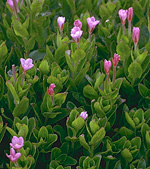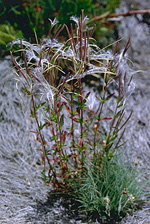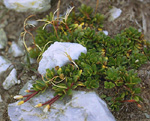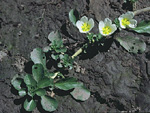 |
This is a cosmopolitan family, especially rich in North America. Five genera occur in Australia. Three of these are introduced (Fuchsia, Gaura and Oenothera) and found in disturbed places, mostly in temperate areas. One genus (Ludwigia) inhabits wet, swampy places or lagoons and other waterbodies in all mainland states (but most commonly in the tropics). The largest genus, Epilobium, is found mostly in montane or alpine parts of south-eastern Australia in wet areas, but a few species are weeds of gardens, nurseries and other disturbed places.
Characteristic features of the family Onagraceae in Australia include: - herbs or (rarely) shrubs, often with alternate and opposite leaves on the same plant, hairy or glabrous
- flowers usually 4-merous, often with a partly-free hypanthium
- inferior, often elongate ovary (in Epilobium the ovary may look like a long pedicel)
- fruits usually capsular with many, fine, arillate seeds that sometimes (Epilobium) have soft, spreading hairs for wind dispersal
Description
Evergreen shrubs, or annual, biennial or perennial terrestrial herbs, or aquatic herbs free-floating at or below the water surface or rooted in the substrate with their leaves emergent. Perennating by rhizomes or taproots. Vegetative reproduction absent, or by rhizomes. Stem internodes solid or spongy or pithy. Internal secretions not obvious. Plants glabrous, or with simple, glandular or non-glandular, unicellular hairs. Leaves alternate and spiral, or opposite, or if herbs then the leaves cauline, all or mostly basal, or both basal and cauline, petiolate, subsessile or sessile. Stipules absent, or present and distinct and free from the petiole, scale-like, membranous or gland-like, persistent. Lamina simple, symmetric, pinnatifid or pinnatisect; lamina/lobes lanceolate, ovate, elliptic, oblanceolate, ovate, oblong or orbicular; base cuneate, attenuate, rounded or cordate; margins entire, crenate, dentate, serrate or sinuate, ±flat, revolute, recurved, involute or incurved; venation pinnate, with the midrib conspicuous or inconspicuous, and the tertiary venation reticulate or not; surfaces not punctate; herbaceous. All the flowers bisexual. Inflorescences terminal or axillary, consisting of spikes, racemes, panicles or solitary flowers. Bracts present. Bracteoles present or absent. Flowers odourless, sessile or stalked. Floral disc present or absent; nectaries present on the disc. Free hypanthium ±present. Perianth of 2 dissimilar or rarely ±similar whorls. Calyx regular; segments free or apparently fused, with 2–7 sepals or calyx lobes, valvate in bud. Corolla regular or rarely irregular; segments free or fused, with (0–) 2–7 petals or lobes, alternating with the sepals, imbricate in bud; corolla tubular, 1-lipped, white, yellow, red, pink, magenta or purple, without contrasting markings, membranous; claws absent; lobes ±entire or notched, emarginate, bifid or bilobed. Fertile stamens 8 or 10, opposite to the sepals or calyx lobes, free of the corolla, free of the ovary and style, distinct from each other, all ±equal or distinctly alternating long and short. Anthers basifixed or apicifixed, versatile or not versatile, opening sideways or inwards by longitudinal slits, 2-celled. Ovary inferior. Carpels 4, fused; ovary with 1–7 locules. Style terminal, single and unbranched, or single and branched above. Ovules 1–numerous per locule, stalked; placentation parietal or axile. Fruit a dry or fleshy dehiscent or indehiscent capsule with irregular or loculicidal dehiscence, or a nut or berry; the perianth on the maturing fruit deciduous, or dry and persistent. Disseminule macro-surface featureless or with a pappus (coma); micro-surface ±smooth or papillate, brown or grey, dull. Seeds 1–numerous per fruit. Aril absent. Cotyledons 2. Embryo straight.
(Note: this description has been generated from the coded data compiled for the key. Any errors in the key data will be reflected in the descriptions.)
A treatment of the family Onagraceae has been published in:
Flora of Australia 18: 215-243.
Australian genera of Onagraceae (as recognised for the Flora of Australia)
† = some species native, others introduced
* = all species introduced
†Epilobium
*Fuchsia
*Gaura
†Ludwigia
*Oenothera

|
  |

Epilobium gunnianum (flowering plant)
Photo: C.Totterdell © ANBG

Epilobium gunnianum (fruiting plant)
Photo: C.Totterdell © ANBG

Epilobium tasmanicum (flowers and fruit)
Photo: C.Totterdell © ANBG

Ludwigia adscendens (flowering plant)
Photo: J.Wrigley © ANBG

|
 |
|